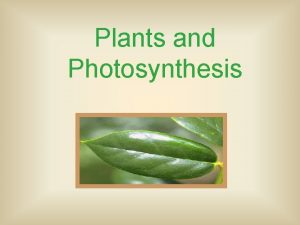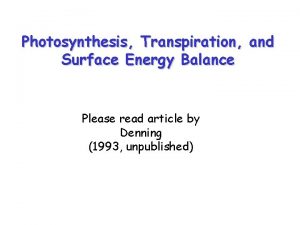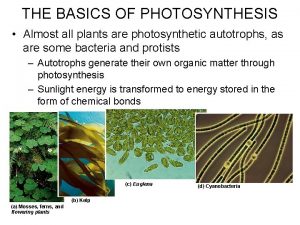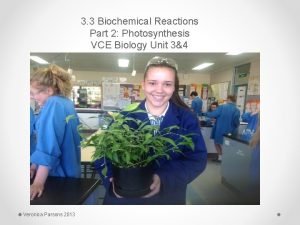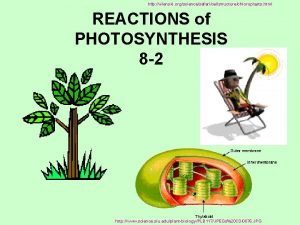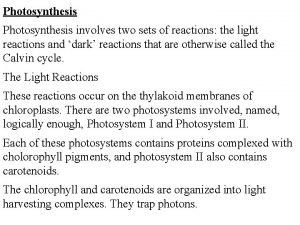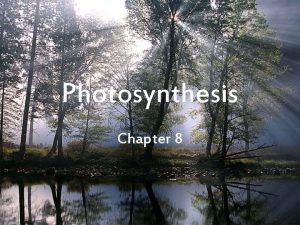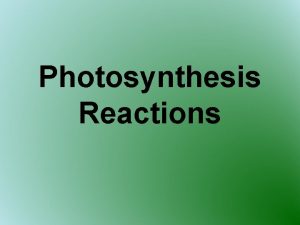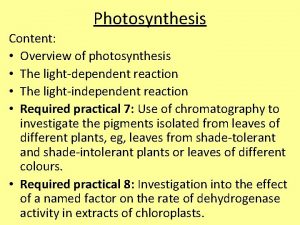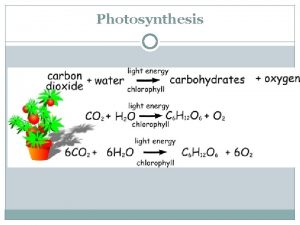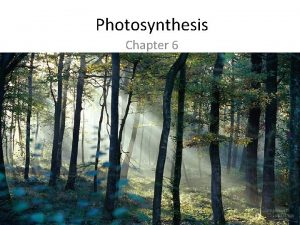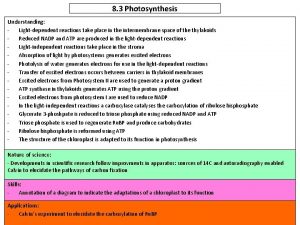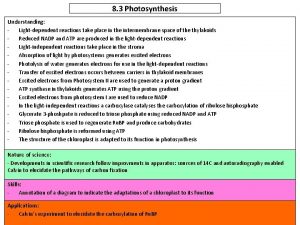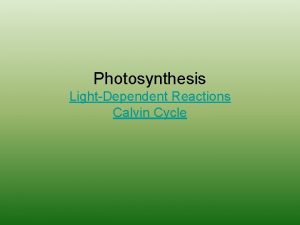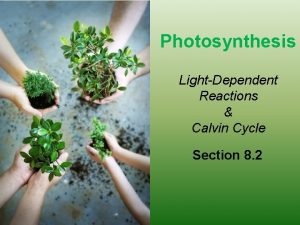Lightdependent reactions Photosynthesis Phase 1 gather light The










- Slides: 10

Light-dependent reactions Photosynthesis

Phase 1 – gather light • The process for gathering light happens on the Thylakoid membrane

Photosystem II – Water split and O 2 production • The Antenna Complex is incorporated into photosystem and uses an absorbed photon to excite an electron and pass it to P 680 (Chlorophyll a) • When the electron reaches • P 680 it energizes it • Excited P 680 then passes • the electron to the primary acceptor, becoming P 680+ Primary Electron Acceptor To replenish the lost electrons, P 680+ oxidizes H 2 O and uses its electrons to return to its grounded state The by-products of this reaction are H+ released into the thylakoid lumen (high[H+]) and O 2 which is expelled

Electron Transport Chain • The primary electron acceptor transfers the excited electron to plastoquinone (PQ) which shuttles the electron to the cytochrome complex • As the shuttle goes it also acquires H+ from the Stroma, when it reaches the complex the H+ is released into the Lumen increasing proton concentration • The electron is transferred through to the Plastocyanin shuttle and sent to Photosystem I (PQ)

Photosystem I • Photosystem I essentially acts like Photosystem II, except that its electrons are replenished by using the electron transport chain (P II) • Electrons from the antenna complex are used first to excite P 700 which donates the electron to the electron acceptor and becomes P 700+ • P 700+ then acquires new electrons from the ETC and becomes grounded (P 700)

Ferredoxin and NADP+ reductase • 2 electrons from the electron acceptor are transferred to 2 Ferredoxin – The first ferredoxin is oxidized and passes an electron to NADP+ and forms NADP – The second ferredoxin is oxidized and transferred to NADP with an H+ from the stroma to form NADPH • NADPH now contains 2 highly excited electrons – The process to create NADPH has shifted the concentration of H+ to low in the stroma and high in the lumen

ATP Synthase • The ATP Synthase functions exactly as it does in cell respiration • The proton gradient created by moving H+ into the lumen is used by ATP Synthase to generate ATP (Chemiosmosis) – Chemiosmosis is not only established by the proton gradient (moving H+ to lumen) but by the splitting of H 2 O and by the formation of NADPH

Lights Major role • The light energy absorbed plays the a critical role in creating the electronegative pull to drive electrons from H 2 O to NADPH. • The electrons travel by being pulled by more electronegative substances but this is a non spontaneous movement and needs input of light energy at points in both photosystem one and two to allow for the movement of the two electrons. As this is movement of electrons from water to NADP+

Cyclic Electron Transport • At times Photosystem I can work on its own without P II • This occurs when reduced ferredoxin goes back to Plastoquinone – This cycle allows more H+ to be moved into the lumen to drive ATP production with ATP Synthase, Calvin cycle needs more ATP then NADPH to reduce CO 2 – Stops production of NADPH

Study Book • Copy Figure 4 from p. 223 and label as well as provide a brief description of what is happening underneath your diagram. • Copy Figure 6 from p. 225 and label as well as provide a brief description of what is happening underneath your diagram.
 Light reactions photosynthesis
Light reactions photosynthesis Structure of chlorophyll
Structure of chlorophyll Inputs of light reactions in photosynthesis
Inputs of light reactions in photosynthesis How to measure photosynthesis
How to measure photosynthesis Plants gather energy with light-absorbing pigments called *
Plants gather energy with light-absorbing pigments called * Light light light chapter 23
Light light light chapter 23 Light light light chapter 22
Light light light chapter 22 Light light light chapter 22
Light light light chapter 22 What are two sets of reactions for photosynthesis
What are two sets of reactions for photosynthesis Section 8-2 photosynthesis
Section 8-2 photosynthesis Section 8-3 the reactions of photosynthesis answers
Section 8-3 the reactions of photosynthesis answers
